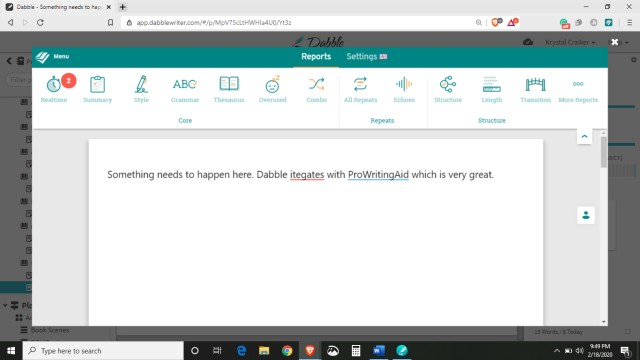
Among novelists, there seems to be a general consensus that Scrivener is the best writing software out there. I always lower my voice a little when I admit that I don’t actually use it. I’ve tried Scrivener several times. It’s a great program with a lot of features, but it just doesn’t meet my needs.
My biggest requirement for novel-writing software is that it’s cloud-based. I’m not a Dropbox user, which works seamlessly with Scrivener, and I don’t like downloading software onto my computer, so I prefer web-based programs. I want to be able to access my novels on any computer or device.
So far, I have used Novlr, Dabble, and StoryShop as alternatives. They all have features that I love. I’m yet to find the perfect novel-writing software for me because I’m picky. And I’m always willing to try the next best thing.
If Scrivener isn’t the program for you, there are plenty of other options out there. Let me share what I’ve found from trying these three.
Novlr
Novlr was the first novel-writing program I tried after Scrivener, and the simplicity of it was appealing. I wrote an entire novella in Novlr, and it was easy to learn and use.
My absolute favorite feature was the encouraging pop-ups as I hit different word counts. They were witty one-liners that popped up at the bottom of the screen as I got closer to my daily targets. I found them to be just enough encouragement to keep going on the tough days. I also think they have the best stats and goal trackers.
Of the three apps I’m reviewing today, Novlr’s mobile feature is the best. If I wanted to quickly add something when I was away from my computer, I could pull it up in my phone’s browser. It synced immediately and any changes I applied were there when I got ready to type again. I’m not someone who can write a lot on my phone, but for people who do, Novlr is your best bet.
Novlr has a great focus mode that you can turn on or off. It gets rid of all the other distractions. There are also day, evening, and night modes.
One of the biggest appeals for me was that it worked both online and offline. It can also sync to Google Drive and Dropbox to back up your work. Novlr’s import and export modes are the most advanced of the three programs I’m reviewing today.
So, what are the drawbacks? For me, Novlr ended up being too simplistic. When I used it, it was only possible to organize by chapter, not scene. They have since fixed that, so if you write scene by scene, Novlr will still work. I also wanted more planning tools. There is a notes section, but I wanted more features than blank documents. However, they do have plans for character profiles and other planning tools in their roadmap.
Novlr is subscription-based software, which allows them to constantly add new features and provide great customer service. It comes in at $10 USD a month, and there’s a slight discount if you purchase a yearly subscription.
Who Should Use It
Novlr is a great program for someone who wants a clean, easy-to-use interface with full syncing capabilities. If you write on your phone often, this is the tool for you. If you don’t do a lot of world-building or plotting, or you don’t need many bells and whistles, Novlr is a great fit.

StoryShop
The next software that I’ve used and loved was StoryShop. If you’re looking for a writing program that is completely different from Scrivener, there’s a good chance this is the one for you.
StoryShop has original features that I’ve never seen anywhere else. What drew me to this software was the world-building option. You can basically build a world bible as you write. In each book is a World Bar. You can add details about characters, settings, species, technology, and more. The level of detail that you can include is incredible. The best part is that you can keep this World Bar up as you write, so you don’t have to switch to a notes section.
The search feature within the World Bar is great. You can also quick-add items by double clicking in the text. If you insert a new character as you’re writing, you can double click the name and add them as a character.
Another advantage of StoryShop is the Series and World features. You can add new books to already created worlds and/or series. Then your World Bar will automatically import to your new manuscript.
My favorite feature was the quick-add method for scenes or chapters. In Scrivener and other programs, you have to click a few buttons to add a new chapter or scene. In StoryShop, hitting Enter twice gives you a scene break, and hitting it three times creates a new chapter. It’s great because you don’t interrupt the flow.
If you want more structure, StoryShop also has Beat Templates. These are basic story structures like Overcoming the Monster, the Quest, and Rags to Riches. These structures largely come from the work of Christopher Booker’s The Seven Basic Plots: Why We Write Stories. StoryShop does include a few more than seven plot structures, though. With StoryShop’s Beats Bar, you can then add more planning details to each scene.
StoryShop is now mobile-friendly for all devices. There is a distraction-free mode and a typewriter mode, which keeps your cursor in the middle of the page to eliminate eye strain and distraction. It does not currently have an offline mode, however, and it is entirely browser-based.
I had some issues with exporting to Word, but I found their customer service to be excellent. StoryShop is one of the newer programs, so it has had some growing pains. But where other apps try to update Scrivener’s layout and features, StoryShop is fresh and innovative.
StoryShop comes in at $9.99 USD a month, with a small discount for buying yearly. They’ve also worked hard to build a writing community and even hosted a writing conference called StoryShop Summit.
Who Should Use It
If you are a fantasy or historical writer who needs a lot of world-building, this is for you. It can help keep track of all your world details, and it can also help you if you struggle with world-building and characterization. There are a lot of bells and whistles, so if you want something very simple, it’s probably not the best fit.
Dabble
I am currently using Dabble as my writing program. Dabble is probably the most similar to Scrivener, although it’s more streamlined and intuitive.
I really enjoy the goal tracker feature. You can set a deadline and a word count goal. You can even exclude already written words from the goal. Then you can easily see where you’re at on the sidebar when you write.
Dabble has a drag and drop feature for organizing parts, chapters, and scenes. You can add scene notes on the right sidebar for extra details, and I like that it’s easy to organize your notes in the notes section. You can create folders just like on Scrivener, and they’re easy to access from the left sidebar.
Dabble’s unique feature is the Plot Grid. You can organize plot lines and plot points in a notecard format. Then you can drag and drop these to help your plots come together. You can turn this into a detailed scene chart or something broader. It’s customizable, and it’s a great plotting tool.

One of the things I love most is that ProWritingAid integrates seamlessly with Dabble. All you need is the ProWritingAid Chrome extension. But what I love even more is that I don’t have to use ProWritingAid until I’m ready. I don’t get distracted with colored underlines. I simply scroll to the bottom of a scene and click the ProWritingAid icon or yellow circle. Then the tool pops up. Any edits I apply also go into Dabble.
Distraction mode starts as soon as you start typing. There is no dark mode, which can be a dealbreaker for some people. Dabble includes both online and offline access, although using the browser offline can be buggy at times. They also have a desktop app you can download for free. Backups are automatic to their servers.
There’s no mobile access yet, but they plan to roll it out this year. You can also visit their Roadmap to see which features are on the horizon.
Like the others, Dabble is $9.99 USD a month. The yearly discount is the greatest of the three apps, with a full 20% discount.
Who Should Use It
Dabble is great for people who want a few more features than Novlr, but don’t need as many as StoryShop. It’s a good choice if you’re familiar with Scrivener and want a similar format. If you like to set word count goals or use ProWritingAid in the same program, this is also the best choice.
Final Thoughts
I truly love these products and would highly recommend all three. They all have features I enjoy, and they are all missing features I want. It’s hard for me to pick a favorite because they are great for different reasons.
The good news is that each of these programs offer a free trial, so I encourage you to try them all and see what works for you. And if you have any recommendations for what software I should try next, let me know in the comments below.
Disclaimer: When we find software that we really love, we often reach out to the company behind it. As such, this post contains affiliate links. This means that if you go on to buy it, ProWritingAid receives a small commission at no extra cost to you.

